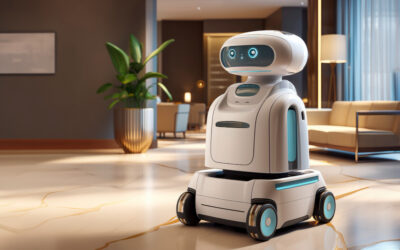Automatons created to perform roles like teacher, dentist, makeup artist, harvester, and cook are emerging. How are these developments progressing, and what role will they play in the medium and long term?
The rapid advancement of artificial intelligence is directly impacting the labor market. Beyond tasks that are automated from start to finish, solutions are emerging that have the capacity to perform multiple tasks previously exclusive to human professionals.
For example, a few months ago, Iris, the first robot teacher, was introduced, giving classes at a secondary school in India. Among other features, it uses generative AI to convert voice to text and vice versa, allowing it to interact with students in three different languages.
More recently, the first fully automatic robot dentist was presented, performing procedures eight times faster than a human dentist could. This system, built by Perceptive, uses a portable 3D volumetric scanner with optical coherence tomography (OCT) to create a detailed 3D model of the mouth, including teeth, gums, and even nerves beneath the dental surface.
“Given that the Da Vinci robot, which is used for prostate, kidney, and bladder surgeries, among others, has existed for years, it was expected that a similar device would eventually appear in dentistry,” explains dentist Ariel Merino. He adds, “I particularly welcome these advances because they bring us precision. When it reaches clinics, it will help professionals be more effective and reduce human errors.”
Although some colleagues view this as a threat or feel resistance to change, Merino sees these robots as complementary to humans: “What I notice in the clinic is that patients trust professionals who use technology and are more innovative.”
The same trend is happening in the agricultural industry. For example, the tomato-harvesting robot, developed by Certhon and DENSO, was recently introduced. Named Artemy, it started operating in August after years of development with the goal of reducing labor by 40-50%. Artemy will harvest cherry tomatoes, currently the main focus. Given the logistics, the robot needs 26.5 seconds per bunch, but without logistical actions such as route changes or box management, the speed increases to 22 seconds per bunch. While a person can harvest 90 kg per day, since humans don’t work 24/7, the robot’s productivity is far superior. According to the robot manufacturer, it will pay for itself in five years.
Another example in the food industry is an entirely automatic robotic solution for processing avocados and other types of fruit. The German manufacturer Kronen claims these robots ensure “high reliability, temperature independence, maximum hygiene, flexible use, and capacity planning.” The robot carefully peels, halves, and de-stones the avocados.
In the food sector, there are also several innovations. One of them is Flippy, a robot that prepares fast food, created by Miso Robotics. It originally started as a grilling robot. Once customers place and pay for their orders, the kitchen receives them, and two robots start working. Flippy can prepare up to 70 kilos of fries per hour, and it can also be programmed to cook chicken strips, onion rings, mozzarella sticks, among other dishes. Another recent case is Beastro, which constitutes the first robotized kitchen in a U.S. university.
There are even innovations in the beauty industry: the Korean company Tonework developed a robot called “The Authentic Color Master” that scans the skin, analyzes it, and creates a customized product from a range of over 200 makeup shades and 366 lipstick colors. Rocio Caldi, Chief Information Officer of L’Oréal in Argentina, Chile & Uruguay, comments that “technology in the beauty industry is essential to continue surprising consumers with innovations.”
Following the same line as Tonework, Caldi explains: “In 2023, we moved from a ‘Beauty for All’ approach to ‘Beauty for Each’ to address the needs, expectations, and desires of everyone with the most personalized approach. Globally, beauty is becoming refreshingly individual: this requires ultra-personalization with the help of Beauty Tech.”
As an example, she mentions Lancôme Hapta, a device designed to apply lipstick using motion detection technology with artificial intelligence. The product adapts to existing lipstick containers, offering 360° rotation and up to 70° of flexion. It features accelerometer and gyroscope sensors that measure the 3D position of the handle, and it includes an integrated AI detection computer that adjusts the device in real-time according to movement. To date, this robot has been tested by over 400 people with movement limitations.
These advances in robotics aim to improve hygiene standards, increase productivity, and ensure human safety in the workplace. However, they also raise concerns about the potential replacement of the human workforce by machines.
“For now, there is no threat to dentists, because the robots must be assisted by a professional, but it may be a concern in the medium and long term when these advances become fully autonomous,” reflects Merino. He adds, “What happens with professionals will depend on whether patients want to have them present in the clinic.” Caldi echoes this sentiment: “New technologies are redefining the world, changing our lives in how we shop, connect, and even learn. This leads to the development of new business models across industries, and the dermocosmetics industry is no exception.”
Despite the efficiency offered by robots, the equation is not so simple. In the mass industry, most consumers still value face-to-face interaction, so robots for customer service positions may not be the best option. This was evident at the Henn Na hotel in Japan, one of the first hotels in the world to have robot concierges. After years of failed experiences, they eventually replaced many of the machines with humans.
Additionally, a study from January this year conducted by MIT CSAIL, MIT Sloan, The Productivity Institute, and IBM’s Institute for Business Value indicates that for businesses, it may be too expensive to replace human workers with AI.
The study investigated the technical requirements and features an AI model would need to perform a job at the level a human could. The researchers then examined whether it makes economic sense for a company to pay for the development and implementation of such an AI system instead of hiring a human worker. The main conclusion of the study is that, in most cases, it would be more cost-effective for companies to continue using human workers for those tasks rather than automating them with AI.
Regarding AI-powered robots entering the market, the interviewees unanimously agree on two things: on one hand, these innovations are currently too expensive, and while AI-powered robots capable of performing various specific tasks are being launched daily, the expected outcome is not replacement but rather a gradual integration of these robots with human workers.
Diario La Nación de Buenos Aires is one of Argentina’s oldest and most prestigious daily newspapers, founded in 1870. It is known for its comprehensive coverage of national and international news, politics, economics, culture, and sports. La Nación is recognized for its conservative editorial stance and its reputation for providing in-depth reporting and analysis. It has a significant influence in Argentina’s media landscape and is considered a key player in shaping public opinion. The newspaper has both a print edition and a strong online presence, offering content in various formats, including articles, videos, and multimedia.






0 Comments